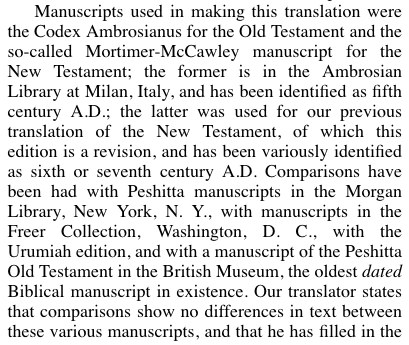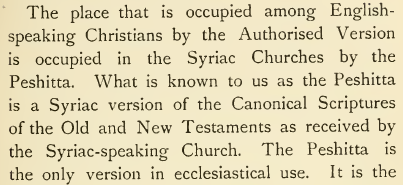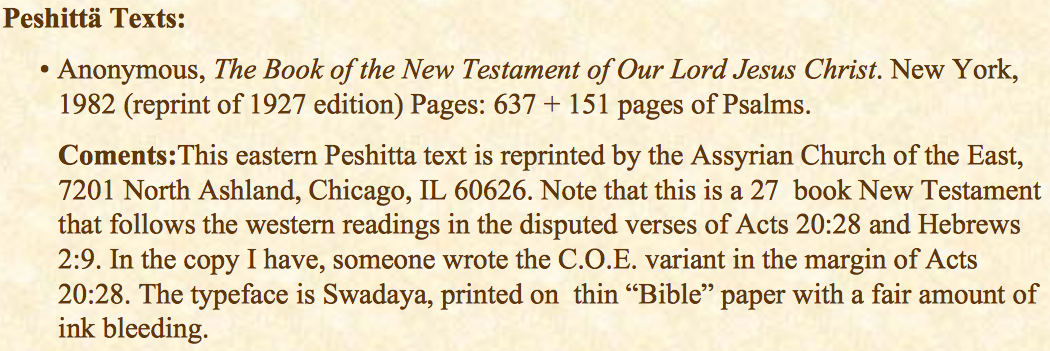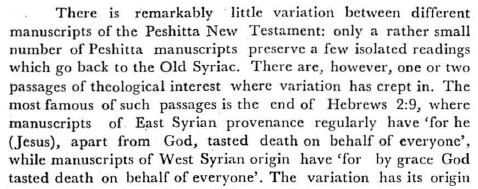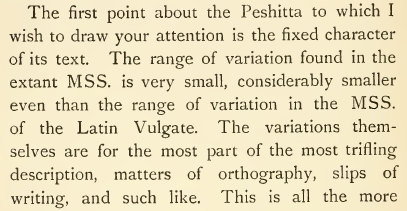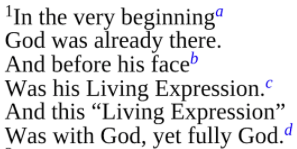The Problem Restated
The reason for my long series of posts about Brian Simmons and his so-called Passion Translation is that sincere Christian believers are reading it, believing it to be a genuine English version of the Holy Scriptures, translated from the original texts, when in fact it is fraudulent, so far as I can see. In many cases where there is an unusual rendering of a verse, Simmons says in a footnote it is translated from the Aramaic. In his FAQs he identifies his Aramaic text as the Peshitta, making it possible to compare his English text with the original from which it is said to be translated. I investigated the first ten such claims in his ‘translation’ of Galatians, and found none of them to be substantiated. What I did find however, was that in the majority of cases, he was following Victor Alexander’s so-called ‘Aramaic New Testament’ which, as its name implies, claims to be a translation of Aramaic scriptures. In these cases, Alexander’s English text, like that of Simmons, does not seem to be translated from the Peshitta.
The question then arises as to whether Alexander might be translating from some other Aramaic source text. In recent years he has consistently refused to say what his source is. He sometimes gives the impression that he may have manuscripts older than the Peshitta, with a different text. For example, as I explained in an earlier post, he has ‘Covenant of the Son of Man’ in Galatians 3.15, rather than ‘human covenant’ as in both the Greek and the Peshitta, and then says in a footnote that:
Only the Ancient Aramaic retains the correct meaning of this passage.
as if perhaps there were some text more ancient than the Peshitta which had this form of text.
More directly, he has implied that he is in possession of the oldest manuscript found, which might further suggest that it is one not known to others:
I don’t need to prove that the manuscript I’m translating from is the oldest found;
‘only bible’ claim
A third way in which he seems to indicate that his source text is not the Peshitta is through his claim (apparently dated 5 June 2014) that his is the only Bible translated from it:
This translation has been made from the Leeshana Supprayah, the Sacred Scribal Language of the Scriptures. This is the only Bible that has been translated from scratch using this language as the source material.
As is well known, both the Old Testament and the New Testament Peshitta were translated into English by George M. Lamsa (1892-1975). His translation was published by Collins in 1957 as ‘The Holy Bible from ancient Eastern manuscripts’. It is impossible that Alexander would not have been aware of Lamsa’s work by 2014.
In the publisher’s Preface, enough information is given to confirm that Lamsa is translating from a normal text of the Peshitta:
Codex Ambrosianus, housed in the Ambrosian Library in Milan, and made common property by Cariani’s photolithographic edition (Milan, 1876-83) has been described as: 1
the most valuable authority which we possess for the Peshitta text of the Old Testament
With regard to the New Testament, I have not been able so far to ascertain what is meant by the ‘Mortimer-McCawley’ manuscript, but it is stated that the text is the same as that of the ‘Urumiah edition’, which for the New Testament is the Ancient Syriac column of the 1846 Urmiyah New Testament, described in my previous post. Thus Lamsa was translating from the Peshitta as normally understood.
If Alexander is translating from the Peshitta, then his is not the first Bible translated from the language of the Peshitta. Possibly, he might have in mind that Lamsa did not translate ‘from scratch’, whereas he, Alexander, is doing so. Apart from that possible explanation, the implication of the claim that his is the only Bible translated from the ‘Sacred Scribal Language’, is that this language is something other than the language of the Peshitta.
In fact, Alexander has not translated the whole Bible, but only the New Testament and a few books of the Old Testament. There have been many translations of the Peshitta New Testament into English, beginning with those of Etheridge (1846, 1849) and Murdock (1852). These two scholars certainly translated ‘from scratch’. Again, if Alexander’s New Testament is the first to be translated from his source language, then that language, whatever it may be, cannot be that of the Peshitta.
Alexander’s source text or texts
In this post, I will endeavour to identify what ancient Syriac source text Alexander is in possession of. In my last post, I drew attention to his 1998 account of how he began translating from an 1897 Modern Syriac New Testament (or possibly complete Bible). Alexander then bought an ancient Syriac New Testament from a Church of the East priest and discovered that the two were different, presumably not only in language but in the form of the text.
He thought he discovered that his modern Syriac version had been translated largely from an English version, but I demonstrated in my last post that he was mistaken in this. I found that it was most probably a reprint of the 1864 New York ‘pocket’ New Testament, which had been translated in Urmiyah from the Peshitta, but into which had later been incorporated Syriac translations of readings from the Greek Received Text. Alternatively, it could conceivably have been derived from the 1893 ‘Labaree’ Bible, whose New Testament, according to one account, had been translated from the Greek.
In this post, I turn my attention to the New Testament purchased from the priest and attempt to demonstrate, rather simply, that it must have been a copy of the Peshitta.
The Church of the East and the Peshitta
It is undisputed that the Church of the East considers the Peshitta Old and New Testaments to be the authoritative scriptures. Rev. Dr. Khoshaba Georges (or Gewargis), Archdeacon of the Ancient Church of the East in London, is a recognised representative of the Church of the East in the UK. He represented ‘The Assyrian Church’ at a conference on Christianity in Iraq at the School of Oriental and African Studies in London in 2004, and is listed as one of the ‘Expert Scholars from the Churches of Syriac Tradition’ at a conference in Vienna in 2009. He states simply that:
This ancient Peshitta is still the only authoritative Bible text of the Old and New Testament for all the Churches of Syriac tradition in the Near East and India.
In 1957, Mar Eshai Shimun, the then Patriarch of the Church of the East wrote to Collins (now HarperCollins) the publisher of George Lamsa’s translation of the Peshitta, ‘The Holy Bible from ancient Eastern manuscripts’, to confirm that:
the Peshitta is the text of the Church of the East
In the same letter, he also made a strong claim of Aramaic primacy, but this need not concern us here. My current purpose is only to demonstrate that ‘the Peshitta is the text of the Church of the East’:
F. Crawford Burkitt, in his 1904 lectures on the Syriac-speaking Church, 2 said that in the Syriac Churches:
The Peshitta is the only version in ecclesiastical use.
David Nienhuis, Professor of New Testament Studies at Seattle Pacific University, wrote in 2007 that 3:
The Eastern Nestorian church holds to the Peshitta version with its twenty-two book NT to this day.
the peshitta new testament canon
The last quotation draws attention to the fact that the New Testament of the Peshitta proper contains twenty-two books, rather than the twenty-seven that are accepted by most churches, as outlined by Sebastian Brock in his ‘The Bible in Syriac Tradition’ (p. 29):
When Justin Perkins arrived in Urmiyah in 1835, he found (‘8 Years’, 14) that the Church of the East knew only these same twenty-two books 4:
But, as I outline below, after the five other books found in the New Testaments of most other churches were added to printed editions of the ancient Syriac New Testament from other ancient sources, the term ‘Peshitta’ has come to be used loosely for New Testaments which contain the Peshitta proper plus these five books.
printed editions of the new Testament peshitta
The first printed edition of the Peshitta New Testament, made by Widmanstadt and Moses of Mardin in 1555, contained twenty-two books only. It was based (p. 272) on two or three manuscripts for the Gospels, and one only for the other books, according to an article in the Church Quarterly Review of July 1888. 5 Tremellius brought out a new edition in 1569, making use of a second MS., and this was followed in 1572 by the Antwerp Polyglot, which included the Syriac, for which yet a third MS was collated (CQR, 283).
In the sixth and seventh centuries, revisions (known as the Philoxenian and the Harklean) were made of the Peshitta which brought it into closer conformity with the Greek editions, with regard to both text and canon. 6 An edition of the Book of Revelation in Syriac was published by Louis De Dieu in 1627, on the basis of a manuscript which, according to John Gwynn, represents a translation ‘which may be provisionally assigned to the first half of the seventh century’. 7 Three years later, in 1630, at the same press in Leiden, Edward Pococke published a Syriac edition of the four Catholic Epistles that are not found in the Peshitta proper. 8 Then in 1645, Gabriel Sionita, a Maronite, in editing the Syriac text of the Paris Polyglot, inserted all five books into it. They were included also in Walton’s London Polyglot of 1657 and, according to Gwynn writing in 1909, all subsequent editions.
Coming to more recent times, an important printed edition of the Peshitta New Testament was that edited by Claudius Buchanan and Samuel Lee, on the basis of a collation of three fresh manuscripts, 9 and published by the British and Foreign Bible Society in 1816. It was followed by the 1846 Urmiyah New Testament in Ancient and Modern Syriac that was described in my last post, which made at least some use of the East Syriac or ‘Nestorian’ type of manuscript. 10 The ancient Syriac Peshitta text of that edition was published separately by the American Bible Society in New York in 1874, and again, ‘revised and corrected’ in 1886, and then ‘repeatedly’. 11
In 1891, the Dominicans of Mosul published an edition of the New Testament Peshitta, that was based upon the Urmiyah edition (plus one seventeenth century manuscript), at the same time as its purpose was to replace it, especially in the Maronite and Chaldean churches that were in communion with the Church of Rome. 12
In 1901 George Gwilliam published a new edition of the Peshitta Gospels, making use of forty-one manuscripts, which had been examined and collated by Philip Pusey and himself. It is a so-called ‘critical’ edition, with variant readings shown in an ‘apparatus’ at the bottom of each page of the text. The intention was to complete such a critical edition of the whole New Testament, but the work was cut short by the deaths of Gwilliam in 1913 and Pinkerton, in military service, in 1916. Instead, a complete New Testament was published by the British and Foreign Bible Society in 1920, making use of the text that had been prepared, but without the apparatus.
Brock, writing around 1989, described this 1920 BFBS Peshitta New Testament as ‘the most reliable one available’. 13 It has been reprinted many time, and was the edition incorporated in the United Bible Societies’ 1985 ‘New Testament and Psalms in Syriac’. 14 The books are placed in the order found in ‘many of the oldest Syriac manuscripts’, with Acts and the three leading Catholic Epistles (James, 1 Peter, 1 John) before Paul’s letters. 15 The five books not found in the Canon of the Peshitta proper are placed at the end, in what the Editorial Superintendent R. Kilgour describes as an ‘appendix’. 16
Finally, mention may be made of ‘The Aramaic New Testament, Estrangelo Script, Based on the Peshitta and Harklean Versions’, published by The Way International in 1983.
the 1982 church of the east printing
John Marucci of Beth Sapra has described an edition of the Peshitta New Testament with Psalms that was published by the Assyrian Church of the East in 1982:
‘Swadaya’ is another name for the Eastern or ‘Nestorian’ script, that was used in both the Urmiyah edition and the Mosul edition. (For the difference between ‘eastern’ and ‘western’ readings, see below.)
I have not so far been able to find this edition in any library catalogue, but that it exists seems certain from its being described also (p. 354) by David Bauscher:
In another reference to this printing, he says (p. 555) that it seems to follow Lee’s 1816 edition:
Lee’s edition was in Serto script, as also is BFBS 1920. The Way International’s edition is in Estrangelo script, which is distinct from the Eastern script. The Urmiyah editions and the Mosul edition have the Eastern script, but they also have the Eastern reading for Hebrews 2.9, 17 So this Church of the East edition, with Eastern script but Western reading of Hebrews 2.9, cannot have been from the same plates as any of these, so far as I can see. But whatever it was, it was clearly a normal Peshitta New Testament, since both Marucci and Bauscher describe it as such, and Bauscher had not found any textual differences between it and Lee’s edition.
The Church of the East priest from whom Alexander purchased a New Testament in ancient Syriac is most likely to have been in the Assyrian Church of the East. If so, it seems highly probable that the priest would have supplied him with the edition that had been published by his own church, and it could well have been the 1982 print that Muricci and Bauscher have had in their possession.
The fact that the Assyrian Church of the East published an edition of the Peshitta New Testament is further demonstration that it is the Peshitta that they consider as their authoritative holy scripture. For this reason it is virtually certain that it is the Peshitta that one of the priests of that church would supply to Alexander.
variation within the peshitta
There is little textual variation between different published editions of the New Testament Peshitta because there is, as Brock puts it: 18
remarkably little variation between different manuscripts of the Peshitta New Testament
The most important variation occurs in Hebrews 2.9b, where manuscripts of East Syrian origin regularly have:
‘for He (Jesus), apart from God, tasted death on behalf of everyone’
while West Syrian manuscripts have:
‘for by grace God tasted death on behalf of everyone’.
In Acts 20.28, mentioned by Marucci above, Western Syrian manuscripts have:
‘… to feed the church of God, which He obtained with His own blood’
while Eastern Syrian manuscripts have:
‘… to feed the church of Christ (ܡܫܝܚܐ , Məšīḥā, Messiah), which He obtained with His own blood’.
These are the only two variants that I have seen mentioned which seem to affect the meaning in an important way. With regard to the Gospels, on the basis of his and Pusey’s study of early Peshitta manuscripts, and comparing with the text used by Widmanstadt, Gwilliam concluded that: 19
the text of the Edition Princeps of 1555 is almost identical with that current at the time our MSS. were written.
Burkitt drew attention to the ‘fixed character of the text’, finding the range of variation to be ‘very small’: 20
With regard to Galatians, the book I have been examining, there are no variations in the text of the Peshitta which could account for any of the discrepancies I have found between Alexander’s English text and the BFBS 1920 text I have been using from from Dukhrana.
alexander resumes translation
After his conversation with the priest, and his obtaining a copy of the New Testament Peshitta, Alexander says in his 1998 account that he resumed translating, but this time from ancient Aramaic:
He went to John’s Gospel and says explicitly that this was the first time he had read it in ancient Aramaic:
The difference he would have found immediately in the first clause of John 1.1 can be shown conveniently with the help of Perkin’s 1846 New Testament, with ancient Syriac in the right hand column and modern Syriac in the left:
The word that stands in the ancient Syriac text in the place that ‘word’ does in English, and λόγος in Greek, is ܡܠܬܐ, melṯā. It is fourth from the right in the right hand column. It is not there in the modern Syriac text. Alexander, viewing the matter from the point of view of an Aramaic primacist (who believes that John wrote in Aramaic, not Greek), claims that λόγος and ‘word’ were poor equivalents for ܡܠܬܐ, obliging him to ‘come up with’ a better one:
He translated ܡܠܬܐ as ‘manifestation’:
despite the fact that no such meaning is given in any Syriac lexicon. What made Alexander believe that is what the word meant? Did he study its usage in ancient Syriac literature, as lexicographers do? Or did he just make something up, the meaning which he thought it should have? For those who, like myself, are deeply concerned about Brian Simmons’ so-called ‘Passion Translation’, and for those, even more so, who are reading his books, sincerely believing them to be the word of God, the question matters, because it is Alexander’s ‘manifestation’ that inspired Simmons’ ‘Living Expression’ in John 1.1:
Andrew
Notes:
- Joshua Bloch, ‘Printed Texts of the Peshitta Old Testament’, The American Journal of Semitic Languages and Literature Vol. 37, No. 2 (Jan. 1921) 143 and n. 4. ↩
- F. C. Burkitt, Early Eastern Christianity, St. Margaret’s Lectures, 1904, On the Syriac-speaking Church (New York: Dutton, 1904)pp. 41, 52-3. Link. ↩
- David Nienhuis, ‘Not by Paul alone: The formation of the Catholic Epistle Collection and the Christian Canon’ (Waco: Baylor University Press, 2007) 80 ↩
- Justin Perkins, ‘A Residence of Eight Years in Persia among the Nestorian Christians, with Notices of the Mohammedans’ (Andover: 1843) 14 ↩
- ‘The Printed Editions of the Syriac New Testament’ Church Quarterly Review, Vol. 26, July 1888 (London: Spottiswoode, 1888) 272 ↩
- Brock, ‘The Bible in the Syriac Tradition’, 1st ed., (Kerala: St. Ephrem Ecumenical Research Institute, 1989) 30-32 ↩
- John Gwynn, ‘The Apocalypse of St. John in A Syriac Version Hitherto Unknown’ (Dublin: Hodges, 1897) xv. ↩
- John Gwynn, ‘Remnants of the Later Syriac Versions of the Bible’ (London: Williams & Norgate, 1909) xx. ↩
- F. H. A. Scrivener, ‘A Plain Introduction to the Criticism of the New Testament’, 4th ed. (London: Bell, 1894) 11. ↩
- For Perkins making much use of local manuscripts, see G. H. Gwilliams, ‘The Materials for the Criticism of the Peshitto New Testament’, Essays in Biblical and Patristic Criticism, Vol. III (Oxford: Clarendon Press, 1891) 55; 56 & n. 1; for Perkins using the 1816 BFBS edition as his basis see Piet Dirksen, “The Urmia Edition of the Peshitta: The Story behind the Text”, in Alexander Rofe (ed.), Textus, Studies of the Hebrew University Bible Project, vol. XVIII, (Jerusalem 1995) 166. ↩
- Isaac H. Hall, ‘The Syriac Translations of the New Testament’, in J. Murdock, ‘The Syriac New Testament Translated into English from the Peshitto Version’, 9th ed. (Boston: Hastings, 1915) 498. ↩
- Joshua Bloch, ‘The Printed Texts of the Peshitta Old Testament’, The American Journal of Semitic Languages and Literature, Vo. 37, No. 2 (Jan. 1921) 141-1. ↩
- Brock, ‘Bible’, 50. ↩
- Note: The date of the New Testament part is given as 1913, but since the editor is Gwilliam, this has to be the same edition. 1913 was the date of Gwilliam’s death, as it happens. ↩
- R. Kilgour, Preface, ‘The New Testament in Syriac’ (London: BFBS, 1905-20) iii. ↩
- Kilgour, ‘BFBS 1920’, iii. ↩
- S. P. Brock, ‘Hebrews 2.9b in Syriac Tradition’, Novum Testamentum, XXVII, 3 (1983) 241. Link. ↩
- Brock, ‘Bible’, p. 30. ↩
- Tetraeuangelium Sanctum, ed. etc. P. E. Pusey, G. H. Gwilliam (Oxford: Clarendon, 1901) v. ↩
- Burkitt, ‘Early Eastern’, 42 ↩

